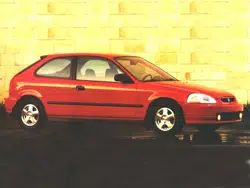
Index
Accessories and Modifications.... 114
Accessories................................. 114
Additional Safety Precaution.... 115
Modifications............................. 115
ACCESSORY (Ignition Key
Position)........................................ 68
Accessory Power Socket................ 83
Adding
Automatic Transmission
Fluid........................................ 161
Brake Fluid................................. 162
Clutch Fluid................................ 163
Engine Coolant........................... 155
Engine Oil................................... 151
Manual Transmission Fluid ..... 162
Power Steering Fluid................. 164
Windshield Washer Fluid......... 160
Additional Information About
Your Seat Belts........................ 40
Lap Belt......................................... 41
Lap/Shoulder Belt....................... 40
Seat Belt Maintenance................ 42
Seat Belt System Components... 40
Additional Information About
Your SRS................................... 43
Additional Safety Precautions.... 46
How Your Airbags Work............ 43
How Your SRS Indicator
Works........................................ 45
SRS Components......................... 43
Additives, Engine Oil..................... 152
Adjustments
Headlights.................................. 184
Head Restraints........................... 75
Mirrors.......................................... 79
Seats.............................................. 74
Steering Wheel............................ 63
Airbag (SRS)...................................... 7
Air Cleaner Element...................... 165
Air Conditioning............................... 86
Maintenance............................... 173
Usage............................................. 86
Air Outlets (Vents).......................... 88
Air Pressure, Tires........................ 175
High Speed Driving................... 231
Normal Driving.......................... 176
Alcohol in Gasoline........................ 233
Antifreeze....................................... 155
Anti-lock Brakes (ABS)
Indicator Light.....................
53, 132
Operation.................................... 13
1
Anti-theft Steering Column
Lock.............................................. 68
Appearance Care........................... 195
Ashtrays (Optional)......................... 83
Audio System................................... 94
Automatic Speed Control................ 64
Automatic Transmission............... 124
Capacity, Fluid........................... 228
Checking Fluid Level................ 161
Shifting........................................125
Shift Lever Position Indicator.. 124
Shift Lever Positions................. 125
Shift Lock Release..................... 128
Battery
Charging System
Indicator............................ 53, 214
Jump Starting............................. 209
Maintenance............................... 169
Specifications............................. 229
CONTINUED
Main Menu
▲
▼
Loading ...
Loading ...
Loading ...
